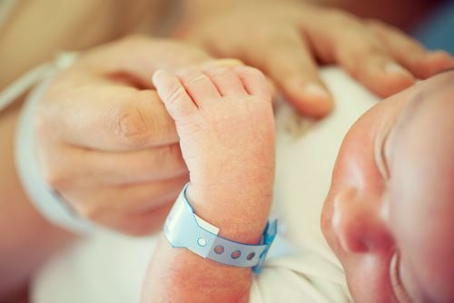Birth injury attorney Leon Walsh discusses umbilical cord problems, how they are treated, and what risks a baby faces with certain cord problems.
When a baby is in the womb, she receives all her oxygen and nutrients from the mother’s blood via the umbilical cord. If the umbilical cord becomes compromised, the baby can suffer very serious consequences, such as oxygen deprivation and improper growth, which can cause problems that include intrauterine growth restriction (IUGR), hypoxic ischemic encephalopathy (HIE), cerebral palsy, seizure disorders, intellectual and developmental disabilities, developmental delays, motor disorders and other birth injuries.
Below is a list of some common umbilical cord problems that can cause a baby to suffer restricted growth and / or oxygen deprivation:
- Umbilical cord prolapse / cord compression
- Nuchal cord (cord wrapped around baby’s neck)
- Short cord
- True knot
- Vasa previa (blood vessels from cord are not inside the cord and instead, are unprotected and lying across the birth canal)
- Infected or inflamed cord
UMBILICAL CORD PROLAPSE
Normally, during vaginal delivery, the baby exits the cervix first, and the umbilical cord follows the baby down the birth canal. When umbilical cord prolapse occurs, the cord travels down the birth canal before or alongside the baby, and the cord can become compressed between the baby’s body and the birth canal. This cord compression can cause the flow of oxygen going to the baby to be cut off or restricted.
Risk Factors for Umbilical Cord Prolapse:
- Premature rupture of membranes PROM). If the mother’s water breaks early, when the baby is still positioned high in the uterus, the cord may travel to the birth canal before the baby can descend.
- Excessive amniotic fluid. Too much amniotic fluid can push the cord down so that it travels through the birth canal before the baby.
- Cord presentation. This is when, before the water breaks, the umbilical cord is lower in the uterus than the baby. When this occurs, doctors will sometimes recommend a planned C-section to avoid the possibility of cord prolapse.
- Premature delivery
- Long umbilical cord length
- Abnormal fetal presentation (e.g., breech presentation)
- Multiple babies sharing an amniotic sac (the first baby to be born may drag the cord of another through the birth canal)
Signs and Diagnosis:
The most clear sign of a cord prolapse is the emergence of the cord before the baby emerges. However, a prolapse is not always visible because the cord can also come down the birth canal alongside the baby. Signs of fetal distress, such as abnormal fetal heart tracings and heart rate deceleration, may also be an indication that a cord prolapse is present.
Treatment/Management of Cord Prolapse:
Sometimes it is possible for the doctor to move the baby away from the cord, and this may involve use of forceps or a vacuum extractor. These devices often fail (and sometimes cause serious injury to the baby) and an emergency C-section delivery is then required.
NUCHAL CORD (CORD WRAPPED AROUND BABY’S NECK)
A nuchal cord is when the umbilical cord is wrapped around the baby’s neck one or more times. This condition is quite common, an occurs in about 20-30% of pregnancies. Sometimes a nuchal cord resolves itself; other times it continues until labor and delivery. Sometimes if may occur shortly before or during the time of delivery. Tightly wrapped nuchal cords are very dangerous because they can strangle the baby. Also, if the cord becomes compressed against itself or compressed against the baby’s neck, this cut off oxygen supply to the baby. In other words, a nuchal cord can threaten blood and oxygen flow through the umbilical cord (and to the baby) in multiple ways.
Risk Factors for a Nuchal Cord:
- An abnormally long umbilical cord length
- An especially active fetus
- Abnormal fetal presentation
- Multiples sharing an amniotic sac (cords of twins or other multiples may become tangled around their own necks or their siblings’ necks)
- Excessive amniotic fluid
- Marginal cord insertion
- Pregnancy duration of more than 42 weeks
- A male fetus
Signs and Diagnosis of Nuchal Cords:
If a baby’s movement slows after 37 weeks gestation, that may be a warning sign for a nuchal cord. Another indication is a decreased fetal heart rate.
Nuchal cords are often diagnosed by ultrasound. It is often necessary for doctors to look at the fetal neck from multiple angles. If an umbilical cord is seen around at least ¾ of the neck, a diagnosis of nuchal cord is made.
Treatment/Management of Nuchal Cords:
Nuchal cords can sometimes be managed by the obstetrician or nurse reaching into the birth canal and maneuvering the cord so that it is no longer wrapped around the baby’s neck. If the umbilical cord is wrapped too tightly to do this, it may be clamped and cut after the baby’s head is delivered. Often, an emergency C-section is necessary.
SHORT UMBILICAL CORD
Long umbilical cords put the baby at risk for a number of complications, but short cords are also dangerous. The main issue caused by a short cord is placental abruption, which can occur when the baby’s movement causes the umbilical cord and placenta to become partially or completely detached from the uterus. This detachment leads to bleeding during delivery. The cord itself can also rupture. Both of these issues can reduce or eliminate oxygen supply to the baby.
Risk Factors for Short Umbilical Cord:
Insufficient fetal movement is a risk factor for a short umbilical cord. Normally, as the baby moves around in the womb, the cord stretches and becomes longer. If the baby is relatively inactive in the first half of pregnancy (typically this is caused by reduced oxygen supply), the cord may remain short. Also, a short cord may hinder fetal movement. Other risk factors for a short cord include:
- Preeclampsia
- First-time pregnancy
- A small fetus
- Mother is of average weight or underweight
Signs and Diagnosis of a Short Umbilical Cord:
A short umbilical cord should be suspected if there is reduced fetal movement. Signs of fetal distress should also induce the physician to check for short cord (and other risky pregnancy conditions). The length of the umbilical cord can be determined with ultrasound. If the cord is short, the mother and baby should be monitored closely for the rest of pregnancy.
Treatment/Management of a Short Umbilical Cord:
If the umbilical cord is significantly short, or there are signs that the baby is in distress, the mother may be admitted to the hospital for monitoring prior to delivery. If the mother is diagnosed with placental abruption or the baby is in distress, then the medical team should quickly prepare the mother for emergency C-section.
TRUE KNOT
A true knot in the umbilical cord is, simply, when a knot that forms. This can happen when babies move around in the womb. A true knot affects about one in 2,000 pregnancies. A true knot becomes especially dangerous when the baby’s movement stretches the umbilical cord and tightens the knot. This causes vessels in the umbilical cord to become compressed, and limits oxygen supply to the baby.
Risk Factors for a True Knot:
- Twins sharing an amniotic sac.
- Excessive amniotic fluid (polyhydramnios)
- A mother who has been pregnant two or more times previously
- A mother who is older than 35
- Long umbilical cord
Signs and Diagnosis of a True Knot:
A baby with a true knot in her umbilical cord may show decreased movement after week 37 of pregnancy. There may also be signs of distress, such as an abnormal fetal heart rate. Usually, diagnosis of a true knot occurs with an ultrasound.
Treatment/Management of a True Knot:
If the physician diagnoses a true knot, the baby should be very closely monitored. Often, the mother will be admitted to the hospital for observation so that emergency intervention (usually a C-section) can be performed if the knot tightens and the baby begins to show signs of distress.
VASA PREVIA
Normally, fetal blood vessels run through the umbilical cord, connecting the baby to the placenta. Vasa previa is a condition whereby fetal blood vessels move out of the umbilical cord’s protection and travel through the membranes that lie across the birth canal. In other words, some of the important fetal blood vessels are unprotected and are lying across the opening to the birth canal. This can be caused by:
- Umbilical cord implantation in the fetal membranes instead of in the placenta;
- The placenta is divided into two “lobes.”
Vasa previa is a dangerous condition because the unprotected fetal vessels may end up rupturing, which can lead to massive blood loss in the baby.
Risk Factors for Vasa Previa:
- Being pregnant with more than one baby;
- Placenta previa;
- In Vitro Fertilization (IVF);
- Previous dilation and curettage (D&C) or uterine surgery.
Signs and Diagnosis of Vasa Previa:
Vasa previa is diagnosed through a transvaginal ultrasound with color Doppler. If it is not diagnosed early, it should be suspected if the mother bleeds when her water breaks.
Treatment/Management of Vasa Previa:
When a mother is diagnosed with vasa previa, she should be carefully monitored. Because vasa previa increases the risk of preterm birth, she should be given a steroid called betamethasone, which will help the baby’s tissues mature. Between 30-32 weeks of gestation, the mother should be admitted to the hospital for more frequent testing. Usually, a C-section delivery is scheduled for about 35 weeks gestation.
INFECTED OR INFLAMED UMBILICAL CORD
Sometimes, a pregnant woman’s infections can spread to the umbilical cord, causing the umbilical cord to be inflamed and infected. Chorioamnionitis is an infection that is caused by from bacteria moving upward through the vagina and into the uterus. Chorioamnionitis can lead to cord infection and inflammation, which is called funisitis. Sometimes, much like other cord problems, funisitis can cause the baby to have decreased oxygen, which can cause serious complications. Chorioamnionitis and funisitis increase the chances of preterm labor and sepsis in the newborn.
Risk Factors for an Infected or Inflamed Umbilical Cord
- Prolonged labor may lead to infection because uterine contractions allow infected vaginal fluid to travel into the uterus.
- Chorioamnionitis is more common in mothers who have previously given birth.
Signs and Diagnosis of an Infected or Inflamed Umbilical Cord
In some cases, when funisitis is present, there may be signs of fetal distress during labor and delivery. Funisitis can be diagnosed through umbilical cord examination and tests of fetal and maternal blood.
Treatment/Management of an Infected or Inflamed Umbilical Cord
If the funisitis is severe, delivery via emergency C-section may be necessary, and the baby will need antibiotic treatment.
THE MICHIGAN MEDICAL MALPRACTICE ATTORNEYS AT GREWAL LAW ARE HERE TO HELP.
If you think your baby experienced a traumatic birth, oxygen deprivation, a brain bleed, delayed delivery, or delayed emergency C-section, or if your baby’s care was mismanaged after birth in the NICU, please contact our team of experienced Michigan birth injury attorneys. The medical malpractice team at Grewal Law is comprised of attorneys and healthcare professionals, including a physician (M.D. / J.D.), registered nurse, pharmacist, paramedic, and respiratory therapist. We also work with the best consultants from around the country. Our attorneys are licensed in Michigan, Arizona and Florida, and we help victims of medical malpractice and birth trauma throughout these states.
If your baby was diagnosed with intrauterine growth restriction (IUGR), HIE, seizures, cerebral palsy, motor disorders, periventricular leukomalacia (PVL), hydrocephalus, intellectual disabilities, or developmental delays, or if you experienced problems during delivery or shortly before or after birth, please call us. Our medical malpractice attorneys and medical staff are available to speak with you 24/7.





